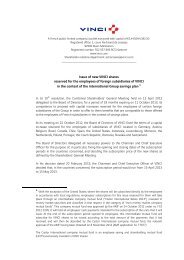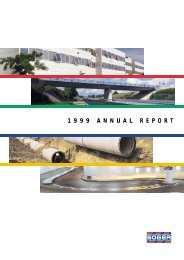VINCI - 2005 annual report
VINCI - 2005 annual report
VINCI - 2005 annual report
You also want an ePaper? Increase the reach of your titles
YUMPU automatically turns print PDFs into web optimized ePapers that Google loves.
Joint venture partnerships created for specific construction projects<br />
and that manage revenue of over €45 million (on a 100% basis) are<br />
consolidated proportionately.<br />
CONSOLIDATED FINANCIAL STATEMENTS<br />
31 December <strong>2005</strong> 31 December 2004<br />
Total France Foreign Total France Foreign<br />
Full consolidation 1,364 928 436 1,347 913 434<br />
Proportionate consolidation 302 146 156 291 139 152<br />
Equity method 38 16 22 38 18 20<br />
1,704 1,090 614 1,676 1,070 606<br />
Intragroup transactions<br />
Reciprocal operations and transactions relating to assets and liabilities,<br />
income and expenses between consolidated or equity-accounted companies<br />
are, in general, eliminated in the consolidated financial statements. This is<br />
done:<br />
– for the full amount if the transaction is between two fully consolidated<br />
entities;<br />
– applying the percentage of consolidation of an entity if the transaction<br />
is between a fully consolidated entity and a proportionately consolidated<br />
entity;<br />
– applying the percentage owned of an equity-accounted entity in the case<br />
of internal profits or losses realised between a fully consolidated entity<br />
and an equity-accounted entity.<br />
Revenue realised in the context of concession infrastructure projects which<br />
are included in the consolidated balance sheet is, in conformity with the<br />
Group’s rules in connection with construction contracts, retained in the<br />
statement of income (see below – Construction contracts).<br />
Translation of the financial statements<br />
of foreign subsidiaries<br />
In most cases, the functional currency of foreign subsidiaries and establishments<br />
is their local currency.<br />
The financial statements of foreign entities where the functional currency<br />
is other than that used in preparing the Group’s consolidated financial<br />
statements are translated using the closing rate method. Balance sheet items<br />
are translated at the exchange rate at the balance sheet date and income<br />
statement items are translated at the average rate for the period. Any resulting<br />
translation differences are recognised under translation differences in<br />
consolidated reserves. Goodwill relating to foreign entities is considered<br />
as comprising part of the assets and liabilities acquired and is therefore<br />
translated at the exchange rate in force at the balance sheet date.<br />
3. MEASUREMENT RULES AND METHODS<br />
Use of estimates<br />
The preparation of the financial statements under the IFRSs requires<br />
estimates to be used and assumptions to be made that affect the amounts<br />
shown in these financial statements, in particular as regards the following<br />
items:<br />
The other joint venture partnerships are consolidated by recording<br />
<strong>VINCI</strong>’s share of revenue and expenses in the income statement, but<br />
the full current accounts of joint venturers in the balance sheet.<br />
Foreign currency transactions<br />
Transactions in foreign currencies are translated into euros at the exchange<br />
rate at the transaction date. At the balance sheet date, financial assets and<br />
monetary liabilities expressed in foreign currencies are translated at the<br />
closing rate. Resulting exchange gains and losses are recognised under<br />
foreign exchange gains and losses and are shown under other financial<br />
income and expenses in the income statement.<br />
Foreign exchange gains and losses arising on loans denominated in<br />
foreign currency or on foreign currency derivatives used to hedge investments<br />
in foreign subsidiaries are recorded under translation differences<br />
in equity.<br />
Business combinations<br />
<strong>VINCI</strong> applies the so-called purchase method for business combinations<br />
made as from 1 January 2004. In application of this method, <strong>VINCI</strong> recognises<br />
the identifiable assets, liabilities and certain contingent liabilities at their<br />
fair value at the dates when control was acquired.<br />
The cost of a business combination is the fair value, at the date of exchange,<br />
of assets given, liabilities incurred, and/or equity instruments issued by the<br />
acquirer in exchange for control of the acquiree, plus any costs directly<br />
attributable to the acquisition. When a business combination agreement<br />
provides for an adjustment to the cost of the combination contingent on<br />
future events, <strong>VINCI</strong> includes the amount of that adjustment in the cost of<br />
the combination at the acquisition date if the adjustment is probable and<br />
can be measured reliably.<br />
The Group has 12 months from the date of acquisition to finalise recognition<br />
of the business combination in question.<br />
− the period over which assets are depreciated;<br />
− the measurement of provisions and retirement benefit obligations;<br />
− the measurement of construction contract profit or loss using the stage<br />
of completion method;<br />
− values used in impairment tests;<br />
− the valuation of financial instruments at fair value;<br />
− the measurement of share-based payment expenses under IFRS 2.<br />
199
















